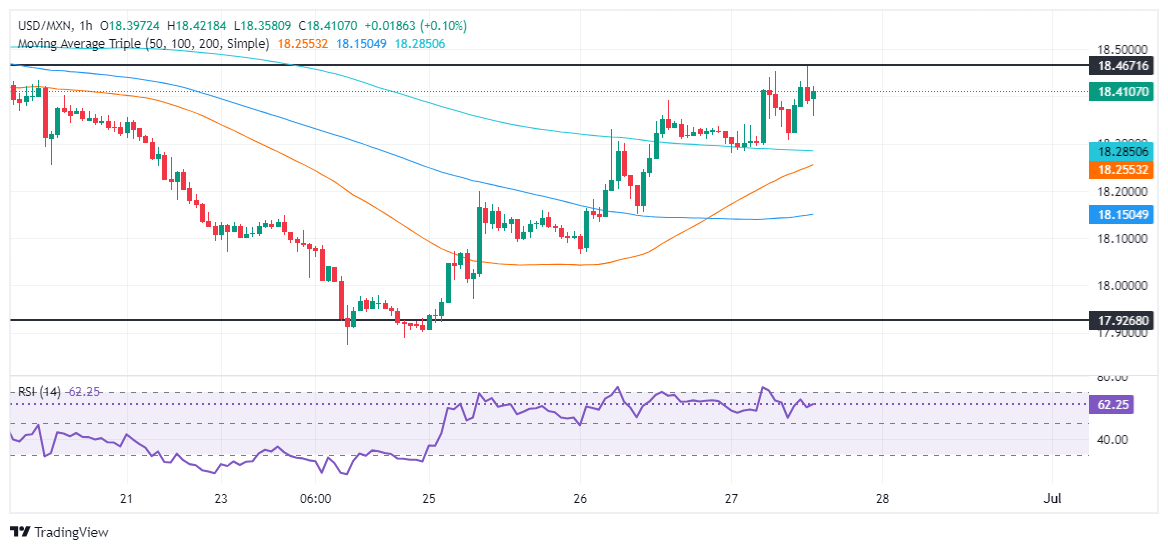- Banxico holds interest rate at 11.00%; Deputy Gov. Mejia Castelazo votes for 25 bps cut.
- Officials cite financial market volatility and unique economic factors in Mexico.
- USD/MXN dips to 18.35 post-Banxico, then climbs, gaining 0.42%.
On Thursday, the Bank of Mexico (Banxico) decided to hold the overnight interbank interest rate at 11.00%, as expected by most market participants. However, the decision was not unanimous, with Deputy Governor Omar Mejia Castelazo's 25-basis-point rate cut vote potentially having a significant impact.
Banxico's unanimous decision fails to underpin the Mexican Peso
Banxico policymakers mentioned that Mexico's financial markets were volatile and affected by “idiosyncratic factors.” Consequently, Mexico’s Government bond yields rose, and the Peso depreciated.
Officials mentioned that the disinflation process is expected to continue, adding that “the board foresees that the inflationary environment may allow for discussing reference rate adjustments.”
They acknowledged that the Mexican Peso depreciation impacted inflation forecasts, which were offset by weaker economic activity; however, the inflation risks balance remains skewed to the upside.
USD/MXN Reaction to Banxico’s Decision
The USD/MXN retreated to 18.35, before resuming its ongoing uptrend, with momentum favoring buyers, as depicted by the Relative Strength Index (RSI) in the hourly chart. The exotic pair trades with gains of 0.42%.
Banxico FAQs
The Bank of Mexico, also known as Banxico, is the country’s central bank. Its mission is to preserve the value of Mexico’s currency, the Mexican Peso (MXN), and to set the monetary policy. To this end, its main objective is to maintain low and stable inflation within target levels – at or close to its target of 3%, the midpoint in a tolerance band of between 2% and 4%.
The main tool of the Banxico to guide monetary policy is by setting interest rates. When inflation is above target, the bank will attempt to tame it by raising rates, making it more expensive for households and businesses to borrow money and thus cooling the economy. Higher interest rates are generally positive for the Mexican Peso (MXN) as they lead to higher yields, making the country a more attractive place for investors. On the contrary, lower interest rates tend to weaken MXN. The rate differential with the USD, or how the Banxico is expected to set interest rates compared with the US Federal Reserve (Fed), is a key factor.
Banxico meets eight times a year, and its monetary policy is greatly influenced by decisions of the US Federal Reserve (Fed). Therefore, the central bank’s decision-making committee usually gathers a week after the Fed. In doing so, Banxico reacts and sometimes anticipates monetary policy measures set by the Federal Reserve. For example, after the Covid-19 pandemic, before the Fed raised rates, Banxico did it first in an attempt to diminish the chances of a substantial depreciation of the Mexican Peso (MXN) and to prevent capital outflows that could destabilize the country.
Information on these pages contains forward-looking statements that involve risks and uncertainties. Markets and instruments profiled on this page are for informational purposes only and should not in any way come across as a recommendation to buy or sell in these assets. You should do your own thorough research before making any investment decisions. FXStreet does not in any way guarantee that this information is free from mistakes, errors, or material misstatements. It also does not guarantee that this information is of a timely nature. Investing in Open Markets involves a great deal of risk, including the loss of all or a portion of your investment, as well as emotional distress. All risks, losses and costs associated with investing, including total loss of principal, are your responsibility. The views and opinions expressed in this article are those of the authors and do not necessarily reflect the official policy or position of FXStreet nor its advertisers. The author will not be held responsible for information that is found at the end of links posted on this page.
If not otherwise explicitly mentioned in the body of the article, at the time of writing, the author has no position in any stock mentioned in this article and no business relationship with any company mentioned. The author has not received compensation for writing this article, other than from FXStreet.
FXStreet and the author do not provide personalized recommendations. The author makes no representations as to the accuracy, completeness, or suitability of this information. FXStreet and the author will not be liable for any errors, omissions or any losses, injuries or damages arising from this information and its display or use. Errors and omissions excepted.
The author and FXStreet are not registered investment advisors and nothing in this article is intended to be investment advice.
Recommended content
Editors’ Picks

GBP/USD trades at fresh 2025-high above 1.3250 after UK CPI data
GBP/USD builds on its six-day winning streak and trades at its highest level since October above 1.3250 in the European session on Wednesday. The data from the UK showed that the annual CPI inflation softened to 2.6% in March from 2.8% in February but had little impact on Pound Sterling.

Gold price approaches $3,300 mark amid persistent safe-haven demand
Gold price continues scaling new record highs through the Asian session on Wednesday and has now moved well within striking distance of the $3,300 round-figure mark. Persistent worries about the escalating US-China trade war and US recession fears amid the ongoing US tariff chaos continue to boost demand for gold.

EUR/USD rises to near 1.1350 ahead of Eurozone HICP inflation data
EUR/USD is trading around 1.1340 during the Asian hours on Wednesday, rebounding after two consecutive sessions of losses. The pair is drawing support from a more positive global risk sentiment, buoyed by US President Donald Trump's decision to exempt key technology products from his newly announced “reciprocal” tariffs.

Exchange inflows surge as XRP slides, what comes next?
Ripple corrected along with other major digital assets, including Bitcoin and Ethereum, and traded at $2.08 at the time of writing on Wednesday. The drawdown cut across the crypto market, causing the total capitalization to drop 3.2% to $2.736 trillion.

Is a recession looming?
Wall Street skyrockets after Trump announces tariff delay. But gains remain limited as Trade War with China continues. Recession odds have eased, but investors remain fearful. The worst may not be over, deeper market wounds still possible.

The Best brokers to trade EUR/USD
SPONSORED Discover the top brokers for trading EUR/USD in 2025. Our list features brokers with competitive spreads, fast execution, and powerful platforms. Whether you're a beginner or an expert, find the right partner to navigate the dynamic Forex market.




